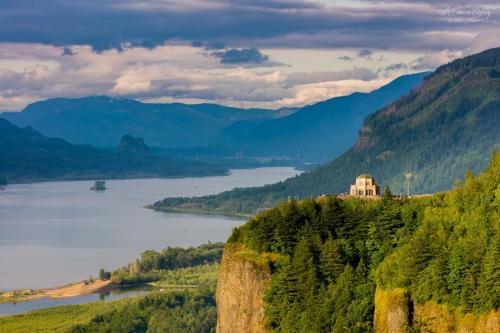Please join us in a special place.
We acknowledge that Skamania Lodge stands on the ancestral lands of the Cascade (Watlala) people, whose homelands extend throughout the Columbia River Gorge. We also recognize the Chinook, Cowlitz, Klickitat, Wasco, Wishram, and other Indigenous peoples who were forcefully removed from this wonderful space.
Approximately 55 miles east of Skamania Lodge is Wy-am (Celilo Falls) on the Columbia River. For thousands of years, Wy-am was a major fishing and trading center and one of the longest-occupied sites in North America. It was submerged in 1957 by the opening of The Dalles dam. To learn more about this place and its importance in the Gorge: https://critfc.org/salmon-culture/tribal-salmon-culture/celilo-falls/

In 1986, federal law created the Columbia River Gorge National Scenic Area. This administrative unit of the USDA Forest Service covers 292,500 acres of mixed public and private lands, with the mission to protect and provide for the enhancement of the scenic, cultural, recreational and natural resources of the Gorge; and to protect and support the economy of the Columbia River Gorge area by encouraging growth to occur in existing urban areas and by allowing future economic development.
The Scenic Area recognizes four treaty Tribes in its management plans: Confederated Tribes of Warm Springs, the Confederated Tribes and Bands of the Yakama Nation, the Confederated Tribes of the Umatilla Indian Reservation, and the Nez Perce Tribe. Other Tribes including the Confederated Tribes of Grand Ronde and the Cowlitz Indian Tribe participate in government-to-government consultation.
The area known to many as the Columbia River Gorge is geologically, ecologically, and culturally unique. To learn why, visit: https://gorgefriends.org/wonders-of-the-columbia-gorge/
Wildfire in the Gorge
All parts of the Gorge typically experience fire starts from spring into fall. Fire is a longtime part of this place, and the majority of fires are human caused. In 1902, the 238,000-acre Yacolt Fire, a series of multiple fires, rapidly burned on both sides of the river on dry September east winds. In 1991, the Multnomah Fire covered 1,200 acres and nearly consumed the Multnomah Falls Lodge. This threat was repeated in 2017, as the Eagle Creek Fire spread rapidly through the western Gorge in Oregon and ignited spot fires in Washington.

Photos (left) 1902 Yacolt Burn, credit USDA Forest Service and (right) 2017 Eagle Creek Fire, credit Trip Jennings
This summer, the Rowena Fire outside of The Dalles and the Burdoin Fire between Bingen and Lyle both deeply affected the area and destroyed many homes. To learn more about fire recovery and support survivors, visit: https://gorgefriends.org/news/united-way-columbia-gorge-and-friends-of-the-columbia-gorge-partner-to-support-rowena-and-burdoin-fire-recovery/